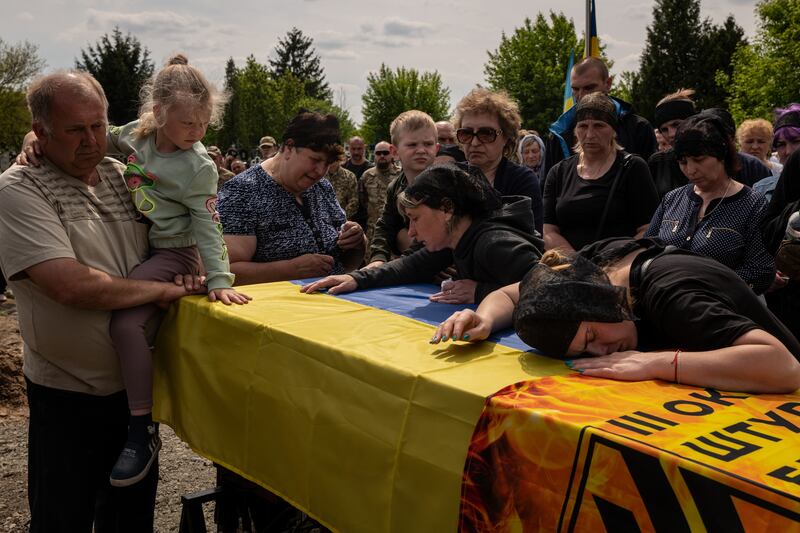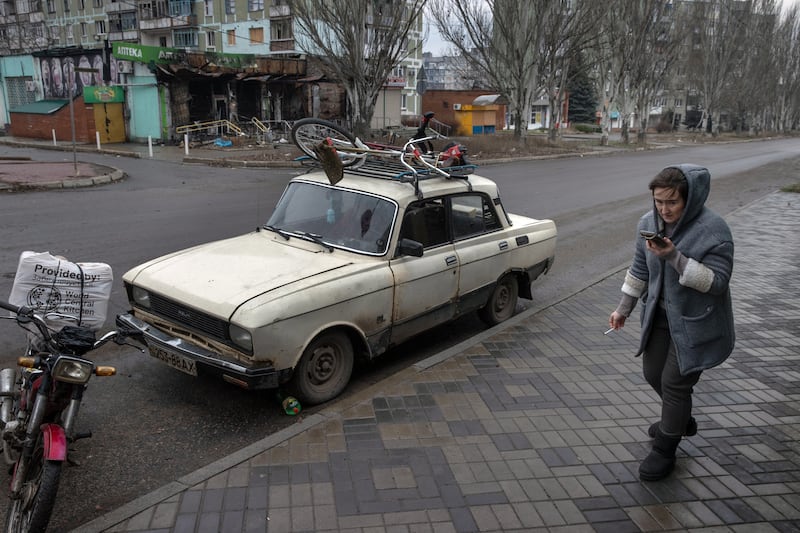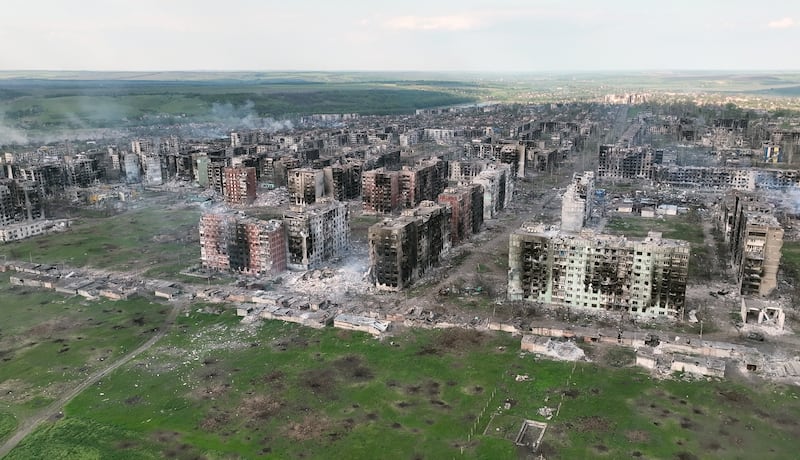It took the Kremlin almost a year and cost the lives of thousands of soldiers to capture Bakhmut, but now that Russian forces appear to have control of the Ukrainian city, it is fair to question the value of what they have gained.
Russia’s state media has been triumphalist. One news anchor declared, “Mission accomplished” over the weekend in a segment that quoted a Russian fighter who compared the seizure of Bakhmut with the Soviet Union’s capture of Berlin in 1945.
By taking Bakhmut, Russia has made its most significant territorial advance since last summer, one that Moscow will try to cast to the Russian people as a sign of military prowess on the battlefield after months of embarrassing setbacks. With his government setting the narrative of the war for a domestic audience, Vladimir Putin has largely hidden its costs, including in Bakhmut, from the Russian people.
Ukrainian deputy defence minister Hanna Maliar essentially acknowledged on Monday that the eastern city had been lost, saying that the Russians were “mopping up” to clear the remaining Ukrainian soldiers from the ruins of Bakhmut.
READ MORE
[ Ukraine military denies Russian claims, says it still controls part of BakhmutOpens in new window ]
General Oleksandr Syrsky, commander of Ukraine’s ground forces, said those few troops would continue defending their ground in order to provide “opportunities to enter the city in case of a change of circumstances” — suggesting that their focus was changing from defending Bakhmut to making it difficult for Russians to hold it.
Indeed, Russia’s grip on the city is far from assured. And beyond the politics and symbolism of capturing Bakhmut, experts say it is highly unlikely that Moscow can convert the conquest of a ravaged city into further gains that would fulfill Putin’s ultimate goal of taking all of the Donbas region in eastern Ukraine.

No independent count of the total casualties has been verifiable, and each side is seen as inflating the other’s losses while concealing its own. But Ukraine’s military has assessed that no fewer than 20,000 Russian troops were killed in the months-long battle and more than 100,000 wounded, according to a senior Ukrainian military official. He made his assessment two months ago, and cautioned that this was a very rough estimate. “There are thousands still rotting there,” the official said.
Ukraine, too, has suffered from high losses. Though Ukrainian officials have refused to give a precise number, their toll most likely includes many thousands killed and wounded.
The city, once home to about 80,000 people, is mostly a pile of rubble, with no electricity, water or much else that could sustain an occupying force or serve as a base for launching further incursions into Ukrainian territory. Ukraine’s military has fallen back to far more defensible lines on higher ground outside the city.
What this means, according to military experts, is that the Russian forces, having taken Bakhmut, now have limited options for going further.
“Look up ‘Pyrrhic victory,’” said Ben Barry, a senior fellow at the International Institute for Strategic Studies, a research group based in London. “A victory which imposes such casualties on the side that supposedly wins the battle that it actually doesn’t help them achieve their strategic ends.”
This is most likely what Russia has achieved in Bakhmut, Barry said, though he cautioned that there were many unknowns, including the possibility that Russia had reserved its more elite, well-prepared units for additional offensive operations along the sprawling eastern front. Ultimately, though, few significant changes on the battlefield should be expected immediately, Barry and other experts said.
One document among the leaked Pentagon materials that were discovered circulating online last month describes a US intelligence assessment of Russia’s campaign in the Donbas as “headed toward attrition.”

“Russian tactics have diminished Russian forces and munition stockpiles to a level that barring an unforeseen recovery can exhaust Russian units and frustrate Moscow’s war aims, resulting in protracted war beyond 2023,” the document said.
Avril Haines, the US director of national intelligence, told the Senate Armed Services Committee in May, that “if Russia does not initiate a mandatory mobilisation and secure substantial third-party ammunition supplies beyond existing deliveries from Iran and others, it will be increasingly challenging for them to sustain even modest offensive operations.”
Russia faces another challenge, as well. Hours after declaring “victory” over the weekend, Yevgeny Prigozhin, the head of the Wagner private military company that led the assault on Bakhmut, said he would begin withdrawing his fighters this week. “From June 1st, not a single Wagner PMC fighter will be at the forefront until we undergo re-formation, re-equipment and additional training,” he claimed.
Withdrawing forces from an active front is no simple task. Given the widely reported tensions between Wagner and Russia’s military leadership, and communication problems within the Russian ranks, analysts say Ukraine will be watching for fissures to exploit. Moreover, away from Bakhmut, along hundreds of kilometres of front line, Ukraine’s forces are gearing up for a major counteroffensive.

The battle for Bakhmut has been a slog for both armies, gobbling up resources, people and time for what appears to be limited strategic gain. But Russia has borne those costs inordinately, according to experts and Ukrainian and Western officials, all in search of a battlefield victory that eluded the Kremlin for months.
When it began last summer, the battle for Bakhmut made more strategic sense. At the time, Russian forces had controlled a large area of territory in northeastern Ukraine and had set up a major military staging area in Izium, a railway hub to the northwest. By punching south from there and toward Bakhmut, Russian forces hoped to squeeze Ukraine’s military out of the northern part of the Donetsk region by enveloping the cities of Kramatorsk and Sloviansk.
But a swift offensive by Ukrainian forces in the late summer and early autumn cleared Russia’s military out of Izium and out of a large chunk of Ukraine’s northeast. This removed the Russian threat from the north and allowed Ukraine to fully array its forces against the Russian troops moving in from the east.
“You could argue that, having lost Izium, the Russian military doesn’t have a way to encircle this part of the Donbas,” said Michael Kofman, the director of Russia studies at CNA, a Virginia-based defence research institute, who was in Bakhmut this year.
Speaking before the Russians gained near total control of Bakmut this weekend, he said the capture of the city “is likely going to represent a tactical gain at a strategic cost and, at the cost of ammunition and manpower expended, may not make much strategic sense.”

Whereas Russia has used military contractors and former prisoners from Wagner for the bulk of the fighting, the Ukrainian troops in Bakhmut were from the regular army, as well as from elite special forces units, which Ukraine can ill afford to waste.
Western allies had also questioned whether Ukraine was making the best use of its ammunition by taking a stand at a site of seemingly limited strategic value. There have been sharp questions, too, from the Ukrainian public — as well as grumbling in the ranks — over the leadership’s decision to keep forces in the city for so long, rather than move them to more defensible positions outside Bakhmut.
By doing so, they locked Ukrainian troops into fixed battle lines that did not play to Kyiv’s strengths. Ukraine’s military has been most successful when its units have been given the flexibility to adapt and operate creatively in battles, attacking where they can find an advantage, but also withdrawing when the odds tip against them.
Just as Ukrainian officials said they wanted to wear down Russian forces at Bakhmut, killing as many as they could, Prigozhin, the Wagner leader, said his aim in Bakhmut was to deplete the Ukrainians there, not to capture the city.
But there are other reasons the Ukrainians held on for as long as they did.
Ukraine’s president, Volodymyr Zelenskiy, has long said that voluntarily ceding any territory, even for tactical gain, would be unconscionable given the abuses that Russian forces have perpetrated against civilians in occupied territories.
As both sides prepare for the next phase of the fighting, Russia’s goal of taking the whole of the Donbas seems no closer than it was months ago. Perhaps it is even further away.
Bakhmut stood in the way of that goal like a brick wall. Russia damaged the city bit by bit and eventually claimed it. But the end result of such a strategy was always going to be a pile of bricks. - New York Times
2023 The New York Times Company












